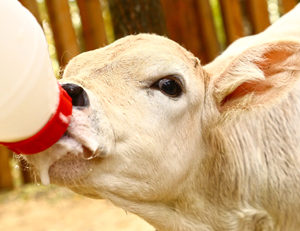Loophole Exploited by Factory Organic Dairies
[This article was previously published in the fall issue of The Cultivator, Cornucopia’s quarterly newsletter.]
by Kestrel Burcham, JD
Farm and Food Policy Analyst at The Cornucopia Institute
 |
All dairy cows must give birth before they begin lactating. The role played by these calves in a dairy’s operation reflects a farm’s dedication to organic ideals.
When a dairy cow “ages out,” or suffers irreversible health problems and is removed from milk production, she is replaced to maintain the same level of production.
Ethical dairies raise the calves they birth out as replacements for declining milk cows, a “closed-herd” method, keeping the animals within the organic system. Factory dairies will often purchase conventionally raised heifers and transition them to organic production.
Under the existing regulations, dairy farmers converting to organic farming are allowed a one-time transition of their existing herd to organic production. After that one-year process, all animals brought into a herd are supposed to be managed organically before birth, for at least the last third of gestation.
However, some industrial-scale organic dairies, with the approval of their certifiers and the USDA, flout this rule by purchasing replacement heifers that were born and weaned using conventional methods.
Conventional management often includes rearing calves on milk replacer made of cheap ingredients, including soy, dried whey, and animal fat mixed with vegetable oil, wheat gluten, and even animal blood plasma (a BSE or “mad cow” risk factor). Often the calves’ diets also contain other synthetic additives and antibiotics—materials banned in organic milk production.
Dairy operations are dictated by their cows’ biological clocks. Cows first “freshen” around their second year of life, beginning to lactate with the birth of their first calf. These calves are raised on a bottle or bucket until they are weaned.
Some certified dairies game the system by selling their calves and buying older replacements from conventional stock. This allows them to not only avoid feeding these calves valuable organic milk, which can be sold at a premium, but also enables them to buy cheaper non-organic animals that they then transition to organic production.
This system of using conventional calves as replacements often goes hand-in-hand with pushing cows for high-volume milk production and maximization of profits. In turn, pushing cows for high- volume production goes hand-in-hand with animal welfare concerns.
This illegal practice puts ethical organic dairy producers at a competitive disadvantage. Raising calves on organic milk cuts into a farmer’s profits.
Current federal rule states both that milk must be from animals that have been organically managed one year prior to milk production and that, once a herd is converted to organic production, all the dairy animals must be under “organic management from the last third of gestation.”
Organic regulations are clear that the continuous transitioning in of conventional animals was not intended. While the rule seems straightforward, the USDA has allowed producers to view this rule as optional.
In 2003, the National Organic Standards Board (NOSB) reiterated that animals may not be rotated between organic and non-organic production. Unfortunately, nothing has changed among factory organic dairies, despite these criticisms.
Ultimately, all replacement dairy animals brought onto an established organic farm should be managed organically from the last third of gestation.
Consumers and wholesale buyers can vote in the marketplace by supporting organic dairies that raise their own replacement cattle. These closed-herd dairies raise their replacement heifers from their own farm-born calves that were fed organic milk—the same quality of organic milk that consumers themselves drink.
People interested in this topic will find a more detailed analysis of these issues in The Cornucopia Institute’s new dairy report, to be released later this year. Our associated dairy scorecard will include a rubric that takes into account how replacement heifers are managed by different dairies, according to the brand.

